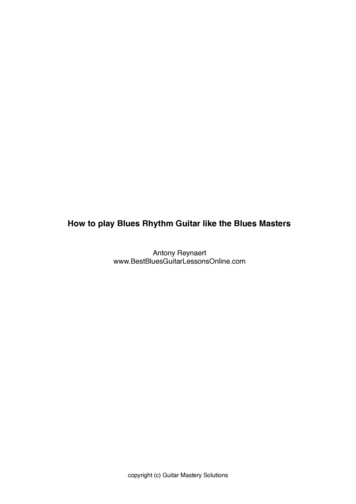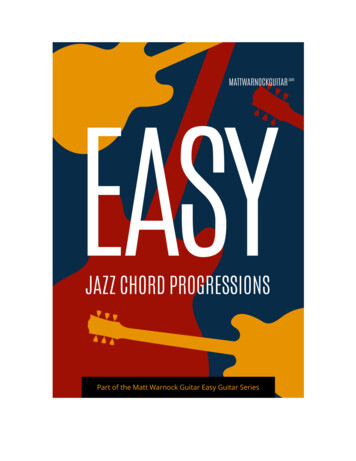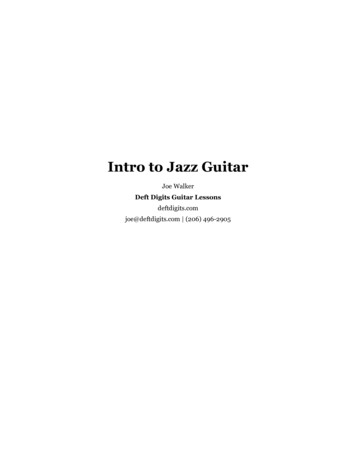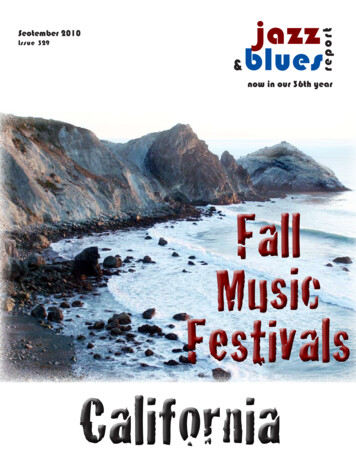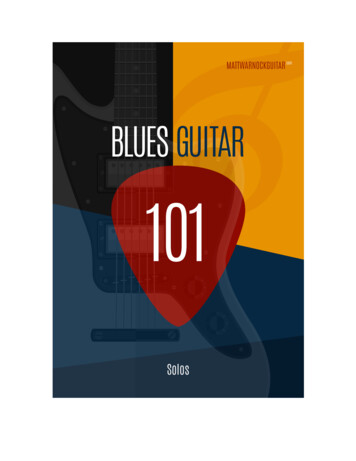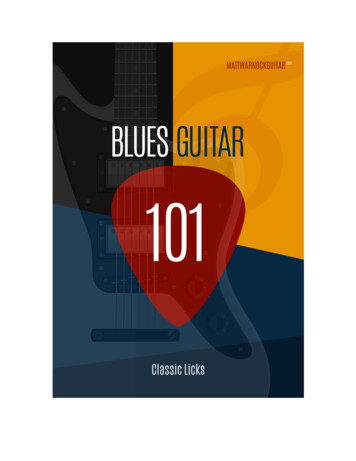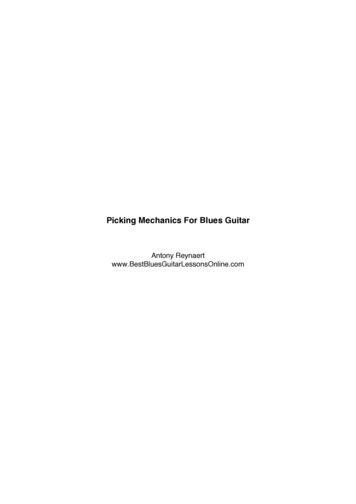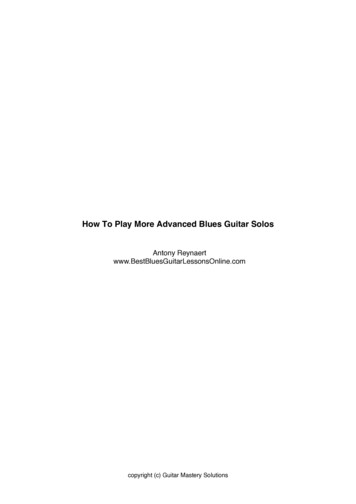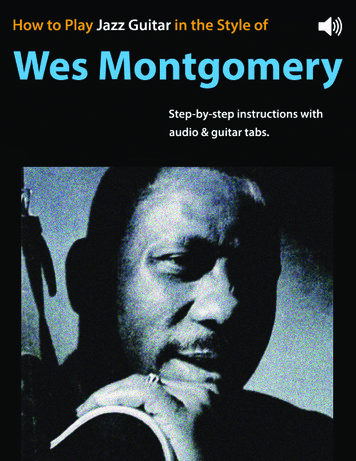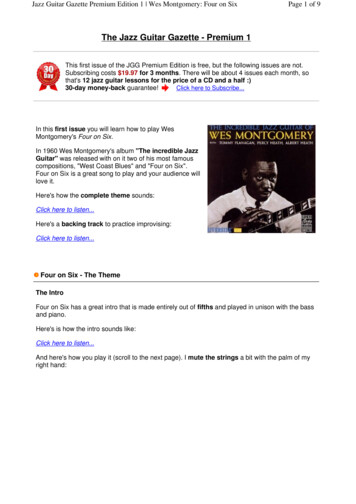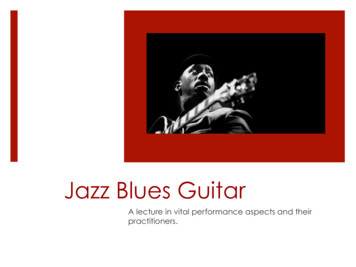
Transcription
Jazz Blues GuitarA lecture in vital performance aspects and theirpractitioners.
¡ Jazz Blues started with musicians such as CharlieParker, Thelonious Monk and Sonny Rollins.¡ Blues has often been affiliated with Jazz music,especially amongst certain artists, and for thepurposes of this lecture, many established guitarists.¡ Django Reinhardt 1910-1953¡ Charlie Christian 1916-1942¡ Wes Montgomery 1923-1968¡ Joe Pass 1929-1994¡ Emily Remler 1957-1990
HarmonyJazz Blues harmony is based around the standardised 12 bar chorus.Here is an example of a Be-Bop blues (based around a cycle of 5ths),used extensively in the 1940’s by Parker and Montgomery.(I7)(IV7)(I7)(V-7)(I7)(IV7)(IV o7)(I7)(III-7)(VI7)(II-7)(V7)(I7)(II-7)(V7)(VI7)
Embellishments¡ This basic chord structure is often embellished.¡ Chord I can be interchanged with Chord V.¡ Common chord tones added to harmonicstructure (in traditional Jazz) are 9ths, 13ths and 9ths.¡ Older style Jazz Blues commonly uses 6th andminor 6ths. (around the time of Reinhardt andChristian)
Example Chord Chart12 bar Chord chart with added chord tones andembellishments.(G713)(C7 9)(C o7)(G7)(C713)(C o7)(A-7/9)(D7 9)(G713)(D7 9)(D 13)(B-7) (E7/9)(G713) (E7/9) (A-7/9) (D7 9)
Demonstration ofEmbellishments¡ Notice use of 13th extension on chord I¡ 9 on chord IV¡ 9 on F 7 (the note of the tonic key so perfectlyacceptable) leading into tonic of G. Otherwise 9’s are rarely used. This can be used to leadback into chord I.¡ Minor/Major 6th in traditional Jazz blues. With 9thextension on chords I and IV.
Melody implied by chordembellishments:Notice how movements are relatively conjunct.Chord shapes are also similar and often parallel shapes.(look at G713 and C7#9)
Voice LeadingWith added chord tones, these extensions work as voiceleading. Adding melodic contour to the harmony.This in addition with a ‘walking’ bass line is extremelyeffective in Solo Jazz Blues guitar (without anaccompanists). The guitarist Joe Pass is famous for thistechnique.This means there is movement in both top and bottomparts of the instrument with important chord tones,predominantly 3rd’s and 7th’s, affirming the harmonicprogressions in the mid-register of the instrument.
How to effectively use VoiceLeading¡ Pedal tones in turnarounds and changes.¡ Common tones, leading into neighboring chords.¡ Conjunct movement.
Chord I¡ Tonic Major¡ Blues pentatonic with ( 5th)¡ Lydian dominant scale, works well when 11th isadded chord tone. G Lydian dominant will workover G7.¡ B Phrygian mode over G7, starting on the 3rd ofthe root note.¡ Stylistic to end phrases on 9th, 13th, 3rd or 7th.
Chord IV¡ IV (C)Major¡ Blues pentatonic with ( 5th)¡ Lydian dominant scale, works well when 11th isadded chord tone. C Lydian dominant will workover C7.¡ E Phrygian mode over C7, starting on the 3rd of theroot note.¡ Stylistic to end phrases on 9th, 13th, 3rd or 7th.¡ (Similar to chord one although it must follow chordtones of IV).
Chord V¡ Dominant 7th scale and arpeggio.¡ Diminished scale over a dominant 7th. Or overC o7 replacing chord V.¡ B (Chord III) Locrian over II, V, I turnaround. (Verystylistic of ‘Jazz’)¡ It is necessary to emphasise the 7th, to createharmonic tension. Voice leading, back to thetonic.¡ When leading back into Chord I, end a phraseusing a scale above on either the root, 3rd, 7th, 9thor 13th of the tonic (G).
Summary:¡ When improvising, these scales and modes workwell as a foundation, however it is sometimesbetter to follow the example of the embellishedharmony to base an improvisation. This will workover chords I, IV and V implying the desiredharmony.¡ This is particularly more effective during cycle of5th turnarounds.¡ Make embellishments sound as natural (asconjunct as possible).¡ Remain consistent stylistically.
Continuity ofStyleIt is important to keep certain elements of the style constant.Chord extensions should predominantly follow the examplesgiven earlier, and solo passages can be improvised overusing certain scales and modes following the harmony ofthe embellished chord chart.Regardless of what embellishments an accompanistprovide, these chords will imply harmony over a standard I,IV, V 12 bar blues.
Solo Performance¡ In solo performance, both accompaniment andmelody must be provided on the guitar. This iswhere the use of walking bass, chord tones andembellishments must be deployed.¡ There is no need to worry about ‘overcrowding’ or‘stacking’ chords, this is perfectly acceptable whenthe guitar is performed as a solo instrument.¡ Interchanging between chords and single notesoloing is good, although it is usual that theapplicable chord is introduced on beat one orconnected on the fourth beat of the previouschord. This can reaffirm the harmony and give theimpression of accompaniment.
Ensemble Performance(Comping)¡ This is where only important guide tones shouldbe played.¡ 3rds and 7ths predominantly.¡ Depending on ensemble, there is usually a bassistor a pianist to play root notes. Therefore spaceneeds to be made for other instrumentalists.¡ Embellishments are good as long as they do notcreate undesired dissonances with otherinstrumentalists. (For example a C#9 against aC9).
IdiomaticPerformance(And Technique)The devices mentioned earlier are applicable to many instrumentsassociated with blues music. However there are fundamentalelements that are unique to Jazz Blues guitar performance.Certain key signatures, techniques and chord inversions workidiomatically, more suitably and widely appropriated for Jazz BluesGuitar. As a consequence, they have become synonymous withthe style.
Key Signatures¡ It is sometimes better to avoid keys such as E, Aand D.¡ Open strings create drones that are undesirableand creates loss of clarity against neighboringchord tones.¡ Desirable keys such as G work well. (Possibility ofusing the dominant 7th below the tonic).Therefore turnarounds work well, Fully utilising thelower register of the instrument.¡ Keys such as B and F are common in Jazzrepertoire.
Devices¡ Octave playing.¡ Single note soloing¡ Chordal soloing.¡ All of these devices are common amongstrespected Jazz guitarists, including Reinhardt,Montgomery and Pass.
Picking Techniques¡ Alternate picking¡ Rest-stroke picking¡ Finger style picking¡ Hybrid picking¡ These techniques are all acceptable and capableof portraying a convincing Jazz Blues performance.However it is better to stick to one throughout apiece to remain constant stylistically.¡ The exception for this is the transition betweenrhythm and solo playing. For example finger style forrhythm and plectrum for solo (greater projection).
Integration of these Devises¡ Successful integration of these devices providethe foundations for improvisations stylistic of JazzBlues Guitar.¡ It is important when performing in an ensembleto be a sympathetic accompanist and not feelobliged to over use the devices. Leaving spacefor other musicians is vital.¡ These Devices will work effectively for any Jazzperformance in which the music has bluesfundamentals, such as similar Harmony.
Musical Example¡ ‘Four on Six’, Wes Montgomery, ‘Smokin’ At TheHalf Note’ (1965)
Four on Six (Montgomery)¡ A modern example of Jazz Blues.¡ 16-bar form.¡ Phrasing and soloing borrows frequently fromblues minor pentatonic.¡ Cycle of 5ths leading back into tonic is typical ofthe Be-Bop style of Jazz Blues.
HeadSingle-note head based around minor blues pentatonic.Ending on the 9th (b.27)
Turnaround Riff(Single-note style) quoted byJoe Pass in ‘Joe’s Blues’.
Octave Playing
Accompaniment¡ This particular standard is almost performed withaccompaniment. So ‘comping’ should be basedupon the other musicians in the ensemble.
Questions
Jazz Blues Guitar A lecture in vital performance aspects and their practitioners. ! Jazz Blues started with musicians such as Charlie Parker, Thelonious Monk and Sonny Rollins. ! Blues has often been affiliated with Jazz music, especially amongst certain artists, and for the purposes of this lecture, many established guitarists. ! Django Reinhardt 1910-1953 ! Charlie Christian 1916-1942 ! Wes .
